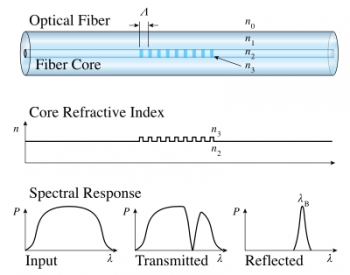
|
| Fig. 1: A Fiber Bragg Grating structure, with refractive index profile and spectral response |
A fiber Bragg grating (FBG) is a type of distributed Bragg reflector constructed in a short segment of optical fiber that reflects particular wavelengths of light and transmits all others. This is achieved by creating a periodic variation in the refractive index of the fiber core, which generates a wavelength-specific dielectric mirror. A fiber Bragg grating can therefore be used as an inline optical filter to block certain wavelengths, or as a wavelength-specific reflector. In Laser lab, there are two students have been studied on FBG. (Fig.1)
- In one research, a numerical model for simulating a dual parameter super-structure FBG (SFBG) with on-fiber deposited thin films is developed. A periodic on-fiber thin coating of silver on FBG sensors provides the ability of measuring two parameters of strain and temperature simultaneously. The model consists of a mechanical model to determine the strain of the sensor caused by different loading conditions, coupled with an optical model to calculate the reflected spectrum of the SFBG sensor. A guideline is introduced for designing a SFBG by studying the effect of coating period, coating duty cycle, and coating thickness. The results show that the sideband spacing in such SFBGs is only affected by the coating period while the Bragg peak sensitivity does not depend on coating period. Also the coating duty cycle and the coating thickness can affect both sensitivity of the Bragg peak and the measuring range of a sensor. The validity of the results was studied by comparing with previously reported data.
This research shows that The sideband spacing depends only on the coating period. The coating period is equivalent with the number of coating segments on the fiber based on the equation L/Γ, where L is the FBG length and Γ is the coating period. Very large period results in mixed sidebands and main peak. In this case, distinguishing the peaks will be difficult or even impossible. On the other hand, very small period requires considering high accuracy during the coating process. In addition to the sideband spacing, the coating period can affect the ‘measuring range’ of the sensor by changing the sideband reflectivity (fig. 2). Fig. 2 shows a typical reflection spectrum of SFBG with different coating period (different number of coating segment) and fig. 3 shows Variation of sideband space with respect to coating period.
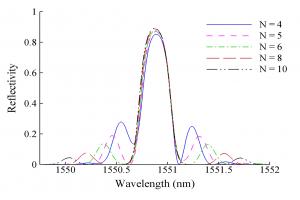
|

|
| Fig. 2: Typical reflection spectrum of SFBG with different number of coating segments at T=75 °C | Fig. 3: Variation of sideband space versus coating period |
The sensitivity of Bragg wavelength remain constant due to the coating period changes. It is determined by the duty cycle and the thickness of the coating, and if the duty cycle and thickness are constants, the sensitivity does not depend on the coating period. For small coating thicknesses, both the thickness and duty cycle can effectively change the Bragg sensitivity. But for the large coating thicknesses, as seen in fig. 4, dependency of the Bragg sensitivity to coating thickness has been reduced and the Bragg sensitivity reaches a constant value. In this condition, the duty cycle is the most effective parameter for changing the Bragg sensitivity. Fig. 5 shows dependence of the sensitivity on the duty cycle. Furthermore, for a desired sideband reflectivity, as can be seen in fig. 6, two different duty cycles can be used which provide two different sensitivities. The smaller duty cycle introduces higher sensitivity to force measurements; while the larger duty cycle would provide higher temperature sensitivity.
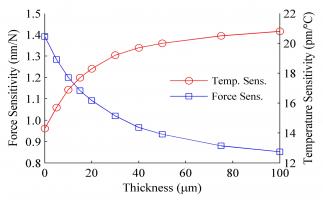
|
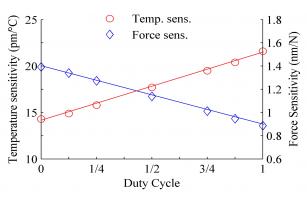
|
| Fig. 4: Force and temperature sensitivity versus thickness | Fig. 5: Force and temperature sensitivity versus duty cycle |
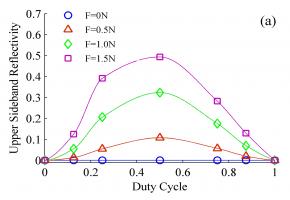
|
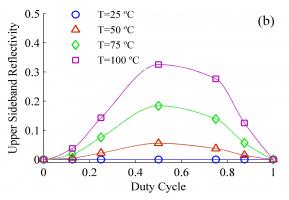
|
| Fig. 6: Reflectivity of first upper sideband versus duty cycle for (a) different tensile loads, and (b) different temperatures | |
The reflectivity of sidebands is a function of all considered geometrical parameters, i.e. changing each parameter results in changing the sideband reflectivity, and subsequently, the measuring rang of the sensor. Among three parameters discussed in this study, the coating thickness is the most important parameter that can affect the measuring rang. By considering the relative reflectivity as RS/RB, the difference between reflection intensity of Bragg and side peak can be written in dBm scale as: ΔI = IB - IS = -10 log (RS/RB), where IB and IS are reflection intensity of Bragg and side peak respectively, also RB and RS are the reflectivity of Bragg and first side peak.
Fig. 7 represents the relation of ΔI with the coating thickness. As can be seen, high coating thickness can cause excessive growth in sidebands reflectivity, which results in negative values for ΔI, i.e. the reflection intensity of the sidebands is more than that of the Bragg peak. In such condition, the Bragg and side peaks could be either difficult or impossible to be distinguished.
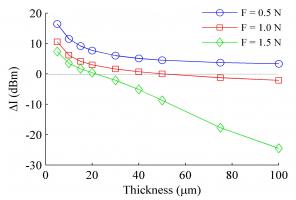
|
| Fig. 7: variation of ΔI versus thickness for force loading |
The results show that finding proper parameters for a sensor with optimal sensitivity for both temperature and force requires careful attention to the application and the range of applied load. For instance, a very sensitive sensor for temperature measurements might be weak in measuring force. Two main features in designing a sensor are sensitivity and measuring range. Measuring range is defined as the loading range where the reflectivity of the sideband varies from near zero to main peak reflectivity. Designing SFBG sensors requires balancing of accuracy and measuring range. Large measuring range needs small sideband reflectivity while high accuracy is achieved by large sideband reflectivity. Therefore, finding optimized parameters is necessary to reach proper performance. This study has been done by Behnam Goodarzi.
- In another dissertation, a class of fiber grating called long period fiber grating (LPFG) fabricated by periodic perturbation via CO2 laser is introduced. Development of fiber gratings in has led to its application as a narrowband filter in dense wavelength division multiplexing (DWDM) optical networks in optical communication, as well as sensors capable of detecting temperature, strain, displacement and other parameters.The fabrication process and characterization of such device is discussed. The LPFG is then simulated by Matlab and Optigrating. LPFG is used as a sensor and the result of simulation of fiber is compared with the results gained from experimental and finally the sensor is evaluated. This study is being done by Mohammad Gheisariha.


